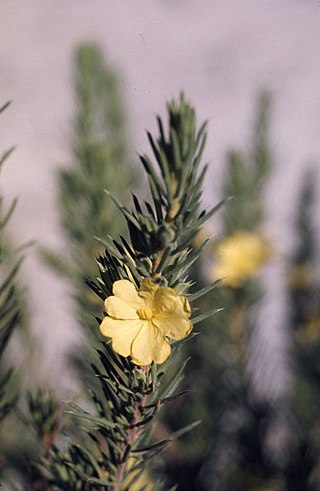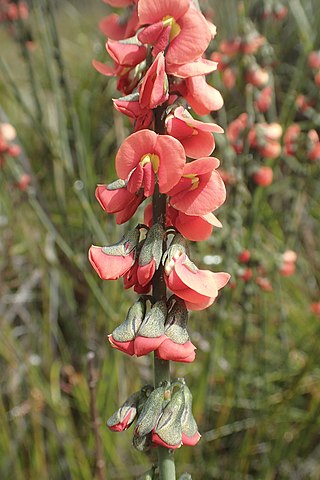
Verticordia eriocephala, commonly known as lambswool, and common, native or wild cauliflower is a flowering plant in the myrtle family, Myrtaceae and is endemic to the south-west of Western Australia. It is a shrub with one densely branching, spreading main stem, small leaves and dense heads of creamy-white flowers, giving rise to the common names "lambswool" and "cauliflower". It is widespread over its range but becoming less common because of land clearing and illegal collecting of the flowers.

Sphaerolobium is a genus of flowering plants in the family Fabaceae and is endemic to Australia, occurring in all states and territories except the Northern Territory. Species of Sphaerolobium are erect shrubs, usually with rush-like stems and yellow or red flowers similar to others in the family.

Hibbertia hypericoides, commonly known as yellow buttercups, is a species of flowering plant in the family Dilleniaceae and is endemic to the south-west of Western Australia. It is usually a spreading shrub with linear to elliptic or egg-shaped leaves, and yellow flowers, usually with ten to fifteen stamens arranged in a cluster on one side of the two densely hairy carpels.
Persoonia manotricha is a species of flowering plant in the family Proteaceae and is endemic to Western Australia. It is an erect shrub with hairy young branchlets, more or less cylindrical leaves and greenish yellow flowers in groups of up two to eight on a rachis 2–15 mm (0.079–0.591 in) long. It is similar to P. bowgada and P. hexagona but has longer pedicels than P. bowgada and differently grooved leaves from P. hexagona.

Grevillea hislopii is a species of flowering plant in the family Proteaceae and is endemic to a restricted area of the south-west of Western Australia. It is a dense, single-stemmed shrub with linear to narrow elliptic leaves and clusters of hairy, whitish-grey flowers.
Hibbertia abyssus, commonly known as Bandalup buttercup, is a species of flowering plant in the family Dilleniaceae and is endemic to a restricted area of Western Australia. It is an erect shrub with linear to tapering leaves and yellow flowers arranged singly in leaf axils with the five stamens all on one side of the carpels.
Hibbertia hooglandii is a species of flowering plant in the family Dilleniaceae and is endemic to the Kimberley region of Western Australia. It is a small, erect or spreading, multi-stemmed shrub with linear leaves and golden yellow flowers arranged singly in leaf axils, with seventeen to twenty-five stamens, all on one side of two densely hairy carpels.

Hibbertia mucronata is a species of flowering plant in the family Dilleniaceae and is endemic to the south of Western Australia. It is an erect shrub with hairy branches, crowded, thick, tapering linear leaves ending in a sharp point, and golden yellow flowers with five stamens fused at their bases, all on one side of two densely hairy carpels.
Hibbertia turleyana is a species of flowering plant in the family Dilleniaceae and is endemic to a small area in the south of Western Australia. It is a low-lying shrub with more or less glabrous, linear leaves and bright yellow flowers with eight or nine stamens in a single group on one side of two densely hairy carpels.
Lechenaultia galactites, commonly known as white leschenaultia, is a species of flowering plant in the family Goodeniaceae and is endemic to the south-west of Western Australia. It is an erect, robust subshrub or shrub with crowded, narrowly oblong to egg-shaped leaves, and white to pale blue flowers.
Lasiopetalum lineare is a species of flowering plant in the family Malvaceae and is endemic to the south-west of Western Australia. It is an erect shrub with densely hairy young stems, linear leaves and bright pink and dark red flowers.

Lasiopetalum molle, commonly known as soft leaved lasiopetalum, is a species of flowering plant in the family Malvaceae and is endemic to the south-west of Western Australia. It is an erect or spreading subshrub or shrub with hairy stems, thick and stiff egg-shaped leaves and pink flowers.
Lasiopetalum monticola is a species of flowering plant in the family Malvaceae and is endemic to the south-west of Western Australia. It is an erect, slender or straggling shrub with densely hairy branchlets, leaves and flowers, egg-shaped leaves and pink, cream-coloured or white flowers.
Olearia elaeophila is a species of flowering plant in the family Asteraceae and is endemic to the south-west of Western Australia. It is a small shrub with scattered linear leaves, and white or blue and yellow, daisy-like inflorescences.
Sphaerolobium benetectum is a species of flowering plant in the family Fabaceae and is endemic to the south-west of Western Australia. It is tuft-forming sub-shrub with erect stems, linear to lance-shaped leaves, and yellow-orange and pink to red flowers.
Mirbelia balsiformis is a species of flowering plant in the family Fabaceae and is endemic to the far west of Western Australia. It is an erect to sprawling shrub with leaves reduced to triangular scales, and yellow to orange and red flowers arranged in racemes on the side of the branchlets.
Mirbelia corallina is a species of flowering plant in the family Fabaceae and is endemic to the far west of Western Australia. It is a slender, sprawling sub-shrub with a few narrowly elliptic to narrowly egg-shaped leaves and pink and yellow flowers arranged in racemes near the ends of the branchlets.
Mirbelia ferricola is a species of flowering plant in the family Fabaceae and is endemic to inland parts of the south-west of Western Australia. It is an erect shrub with leaves reduced to small scales, and red and yellow flowers arranged in racemes at the ends of the branches.

Sphaerolobium rostratum is a species of flowering plant in the family Fabaceae and is endemic to the south of Western Australia. It is an erect to sprawling shrub or subshrub with slender stems, tapering linear leaves and loose racemes of pink and cream-coloured flowers.
Thomasia × formosa is a species of flowering plant in the family Malvaceae and is endemic to a restricted area of the south-west of Western Australia. It is an erect, compact shrub with densely hairy branchlets, hairy, coarsely serrated, egg-shaped to elliptic or oblong leaves, and racemes of pink or purple flowers arranged in leaf axils.






